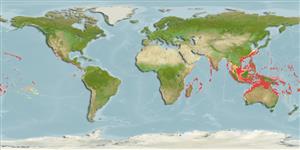>
Eupercaria/misc (Various families in series Eupercaria) >
Labridae (Wrasses) > Bodianinae
Etymology: Bodianus: Bodianus after Bodiano or Pudiano, from the Portuguese pudor, meaning modesty (Jordan & Evermann, 1896); bilunulatus: Name formed from the Latin adverb bis, for twice and Latin diminutive noun lunula (luna + ulus) for 'somewhat like the moon'; apparently referring to the lunate caudal fin (double emarginate with filamentous lobes) of the type specimen (Ref. 75973).
More on author: Lacepède.
Environment: milieu / climate zone / depth range / distribution range
ນິເວດວິທະຍາ
ສັດທະເລ ກ່ຽວກັນຫີນ; ລະດັບຄວາມເລິກ 3 - 160 m (Ref. 9823). Tropical; 30°N - 30°S, 30°E - 134°W
Indo-West Pacific: east coast of Africa to Japan, the Philippines and New Caledonia.
ຂະໜາດ / ນ້ຳໜັກ / Age
Maturity: Lm ? range ? - ? cm
Max length : 55.0 cm TL ຕົວຜູ້/ບໍ່ມີເພດ; (Ref. 4392); ນ້ຳໜັກສູງສຸດທີ່ເຄຍຈັດພີມມາ: 1.8 kg (Ref. 4887)
ຄີ (ໜາມ)ແຂງຢູ່ຫຼັງປາ (ທັງໝົດ) : 12; ຄີຫຼັງຂອງປາ (ຄີອ່ອນ) (ທັງໝົດ) : 10; ຄີ(ໜາມ) ແຂງຢູ່ຄີກົ້ນປາ
ກຸ່ມປາກະດູກແຂງ
ຄວາມຖີ່ຂອງກຸ່ມຖ່າຍທອດພັນ
ປາທີ່ມີການເຄື່ອນຍ້າຍຈາກທະເລໄປຫານ້ຳຈືດ ແລະນ້ຳຈືດຫາທະເລ
ປາທີ່ມີການເຄື່ອນຍ້າຍຈາກທະເລແລະໄປໄຂ່ຢູ່ນ້ຳຈືດ
ຄີກົ້ນຂອງປາ
ສັດທີ່ມີກະດູກສັນຫັຼງ
ການຖ່າຍທອດທາງກຳມະພັນຈາກພໍ່ແມ່ຫາລູກ: 3; ຄີກົ້ນຂອງປາ: 12. Young easily identified by the unusual coloration. Adults normally have an oval shaped black saddle near the tail, but it may become indistinct in large males (Ref. 48636).
Adults occur on deep reef slopes rich with invertebrates such as sponges and seawhips, but young adults are occasionally seen much shallower (Ref. 48636). Usually solitary in coral and rocky reefs. Feed mainly on benthic, hard-shelled, invertebrates such as mollusks and crustaceans. Protogynous (Ref. 55080). Oviparous, distinct pairing during breeding (Ref. 205).
Life cycle and mating behavior
ການຈະເລີນເຕັມໄວ | ການສືບພັນ | ການວາງໄຂ່ | ໄຂ່ | ຄວາມດົກຂອງໄຂ່ປາ | ຕົວອ່ອນ
Oviparous, distinct pairing during breeding (Ref. 205). Size at sex change: 38.6-40.5 cm L (Ref. 55080).
Westneat, M.W., 2001. Labridae. Wrasses, hogfishes, razorfishes, corises, tuskfishes. p. 3381-3467. In K.E. Carpenter and V. Niem (eds.) FAO species identification guide for fishery purposes. The living marine resources of the Western Central Pacific. Vol. 6. Bony fishes part 4 (Labridae to Latimeriidae), estuarine crocodiles. FAO, Rome. (Ref. 9823)
IUCN Red List Status (Ref. 130435: Version 2024-1)
Human uses
ການປະມົງ: ທີ່ເປັນການຄ້າໜ້ອຍ; ຊະນິດປາທີ່ຖືກນຳໃຊ້ເຂົ້າໃນການຫາເພື່ອເປັນເກມກິລາ: ແມ່ນ; ຕູ້ປາ: ເປັນສີນຄ້າ
ເຄື່ອງມື
Special reports
Download XML
ແຫຼ່ງອີນເຕີເນັດ
Estimates based on models
Preferred temperature (Ref.
123201): 23.6 - 28.8, mean 27.4 °C (based on 932 cells).
Phylogenetic diversity index (Ref.
82804): PD
50 = 0.5000 [Uniqueness, from 0.5 = low to 2.0 = high].
Bayesian length-weight: a=0.01230 (0.00569 - 0.02662), b=3.05 (2.87 - 3.23), in cm total length, based on LWR estimates for this Genus-body shape (Ref.
93245).
ຊັ້ນເຂດຮ້ອນ (Ref.
69278): 3.4 ±0.49 se; based on food items.
ຄວາມຢືດຢຸ່ນ (Ref.
120179): ຕຳ່, ປະຊາກອນຕຳ່ສຸດທີ່ໃຊ້ເວລາສອງເທົ່າ 4.5 - 14 ປີ (Preliminary K or Fecundity.).
Fishing Vulnerability (Ref.
59153): Moderate vulnerability (42 of 100).
Nutrients (Ref.
124155): Calcium = 33.5 [19.8, 51.9] mg/100g; Iron = 0.511 [0.303, 0.904] mg/100g; Protein = 18.5 [15.6, 20.7] %; Omega3 = 0.143 [0.098, 0.211] g/100g; Selenium = 44 [27, 72] μg/100g; VitaminA = 82.7 [26.3, 281.8] μg/100g; Zinc = 1.19 [0.88, 1.84] mg/100g (wet weight);
